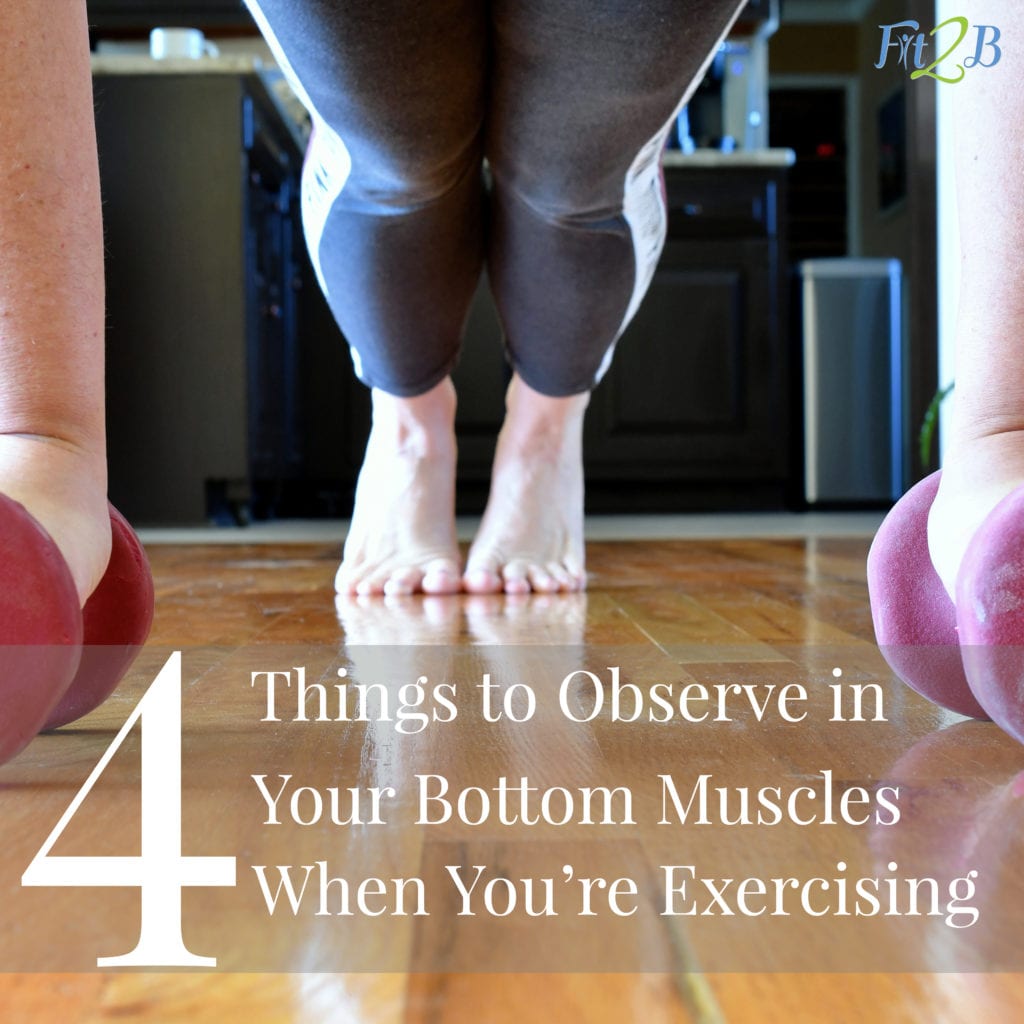Blog, Fit2B Magazine
4 Things to Observe in Your Bottom Muscles During Exercise
My word for the year of 2020 was ‘observe,’ and wow did I ever get loads of opportunities to pay attention to changes in the world! Never before has the ability to workout at home been so valued. One day, while I was working out in my living room – practicing for a future Fit2B filming – I realized that all four things we must seek to observe in our bottom muscles while exercising start with the letter ‘L.’ Interesting, right? Check out 4 Things to Observe in Your Bottom Muscles During Exercise

The good news: All 4 sensations I outline below provide valuable feedback for your fitness journey. More good news: If you do observe a couple of them – like leakage which is common – you can adjust your movement strategies by using Fit2B workouts and seek physical therapy. Medication isn’t your only option, and surgery should be a last resort!
Many personal trainers and fitness instructors will tell you to “Listen to your body and slow down if you notice something.” However, here on Fit2B, we actually teach you what to listen for and what each sensation means. It’s really more about feeling than listening, because you don’t actually ‘hear’ many of your body’s signals that it needs a new strategy or a slower pace. You need to use your inner senses to observe these 4 sensations in your pelvic floor muscles.

Observe these 4 ‘L’s
Leaking
Any amount of pee or poo leaking out while you’re exercising isn’t normal. It’s common among postpartum women and even 1/3 of female athletes (Logan et al, 2018). Urinary and fecal incontinence is a sign of dysfunction, though, which is very treatable with specialized physical therapy and an update to your fitness strategies.
Tip: Seek out a qualified pelvic floor physical therapist who specializes in incontinence and Diastasis Recti. Our research revealed a statistically significant correlation between the two.
Lifting
Do you observe a lifting sensation in your pelvic floor muscles when you exhale? Do you feel the soft tissues between your sitting bones, tailbone, and pubic bone draw inward when you breathe out? If so, that’s good. If not, maybe they never let go. Tight muscles have trouble tightening more. Let it go!
Tip: Imagine you are sucking a smoothie through a straw that’s in your bottom as you breathe out air.

Lowering
Do you feel the soft tissues in your bottom lowering when you inhale? When you breathe in air, do your pelvic floor muscles relax downward and outward? Believe it or not, many people have hypertonic (too tight) pelvic floor muscles and experience trouble “unffexing” down there. The relaxation phase of muscle action is just as important as the flexion phase! We teach strategies for this in several Fit2B workouts, and a physical therapist can help with “down-training.”
Tip: Imagine a Kleenex laying flat and that you’re picking up the middle of it with the centermost part of your bottom muscles as you exhale… but then set it back down completely and let that soft tissue go again as you’re inhaling.
Fact: Your pelvic floor muscle co-activate with your other core muscles. Being able to connect to your bottom muscles at the base of your core can dramatically improve your Diastasis Recti.
Locking
There is the kind of lock that manifests as a sustained sense of closure and lifting of your most intimate muscles, but then there the type of lock that feels like a cramp in your crotch! You should be able to raise and lower your pelvic muscles, pausing at the top and bottom floors of that “elevator” for at least 5-10 seconds. This is known as a Kegel or Mula Bandha “root lock” which we teach in our Foundational Five here on Fit2B.
Tip: If you experience a muscle cramp in your bottom, try sitting on a toilet for a while and taking deep inhales. As you’re breathing in, visualize expanding and softening all your tissues toward the water. Overexertion, scar tissue, anxiety, menses, and many other things contribute to crotch cramps. Observing what mental and physical loads cause too much locking in your body is important.
Leave a comment!
Have you ever noticed these 4 Things to Observe in Your Bottom Muscles During Exercise? What else have you felt? If you were going to add another “L” to listen for, what would it be? Do you have any tips for people who are experiencing these things? What’s your current favorite Fit2B workout for your pelvic floor?

Thank you so much for talking about this. I think the pain I have experienced intermittently over the last two years is the locking sensation. The pain can be pretty intense sometimes and your tip to sit in the toilet is what I’ve done but I haven’t tried the breathing and visualization. Is there anything to do to prevent this? I experienced it just a few days ago after walking/jogging three miles. Thank you ,Beth, for all you and your team does!
Stacy,
The most helpful thing would be for you to find a local physical therapist that specializes in pelvic health that would be to do some internal releasing for you. They feel for scar tissue (adhesions) or tight muscles and work professionally (and gently) to mobilize them. Here’s an article I wrote about that > https://fit2b.us/how-to-find-and-what-to-ask-a-good-pelvic-floor-therapist/
-Beth